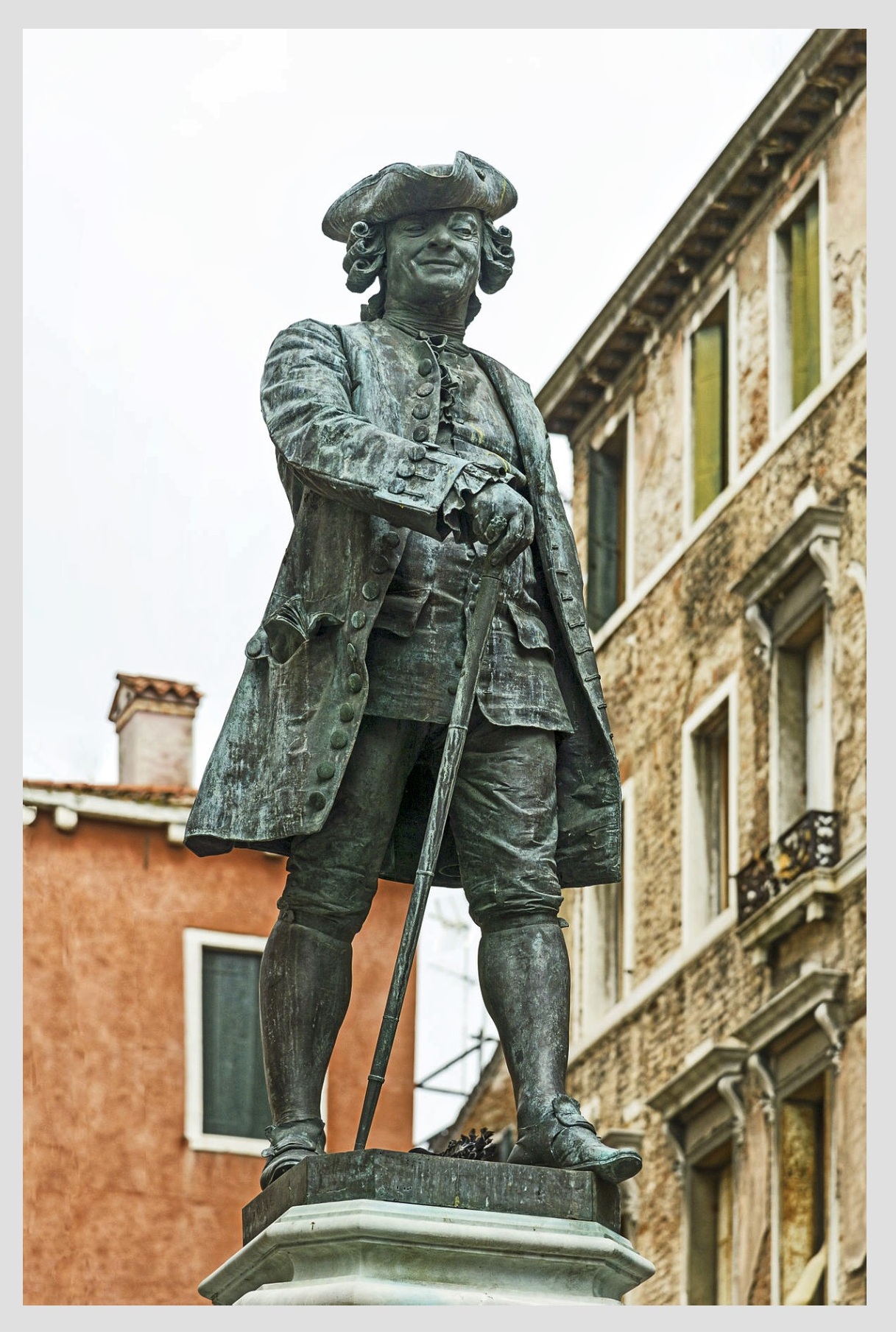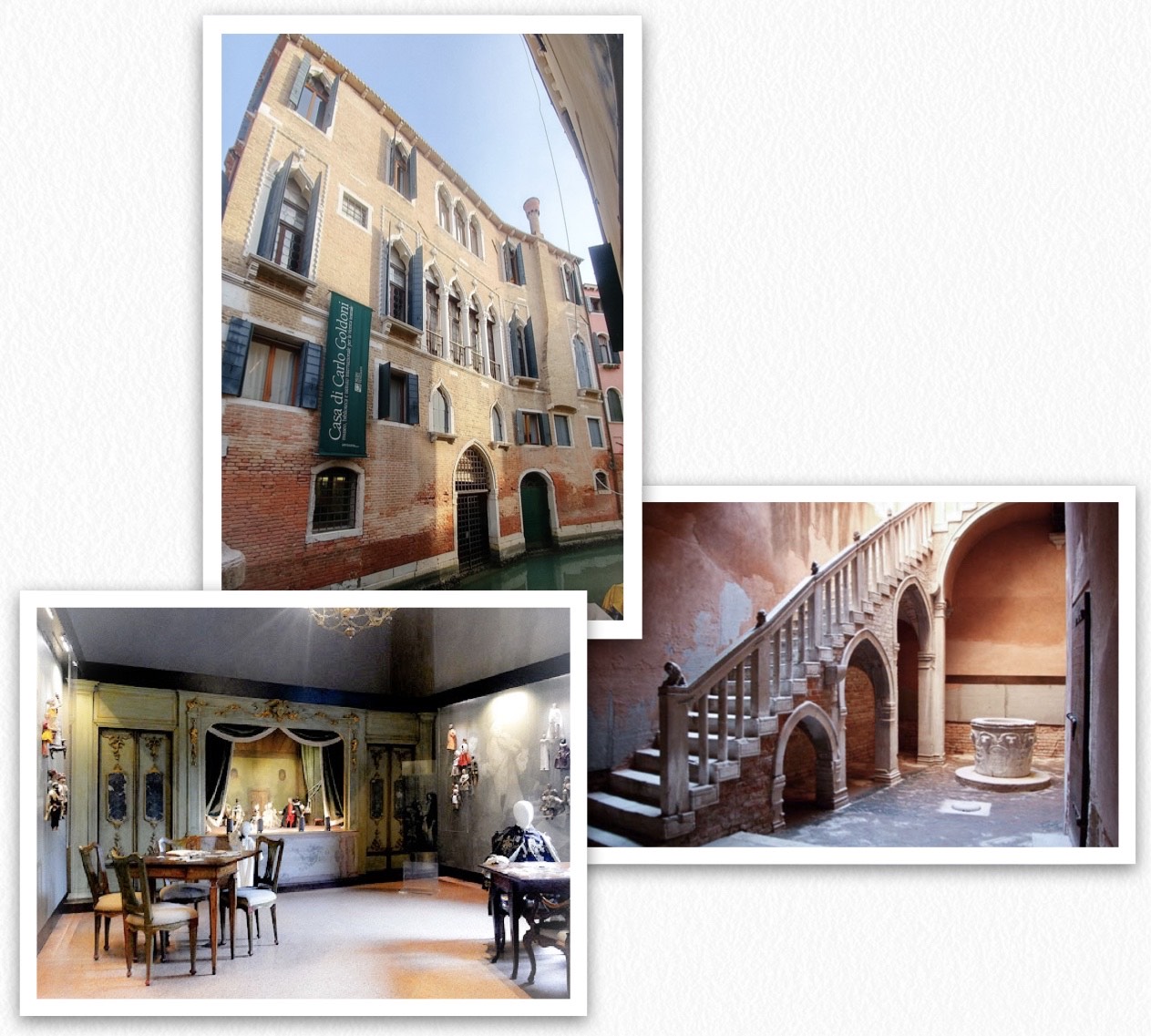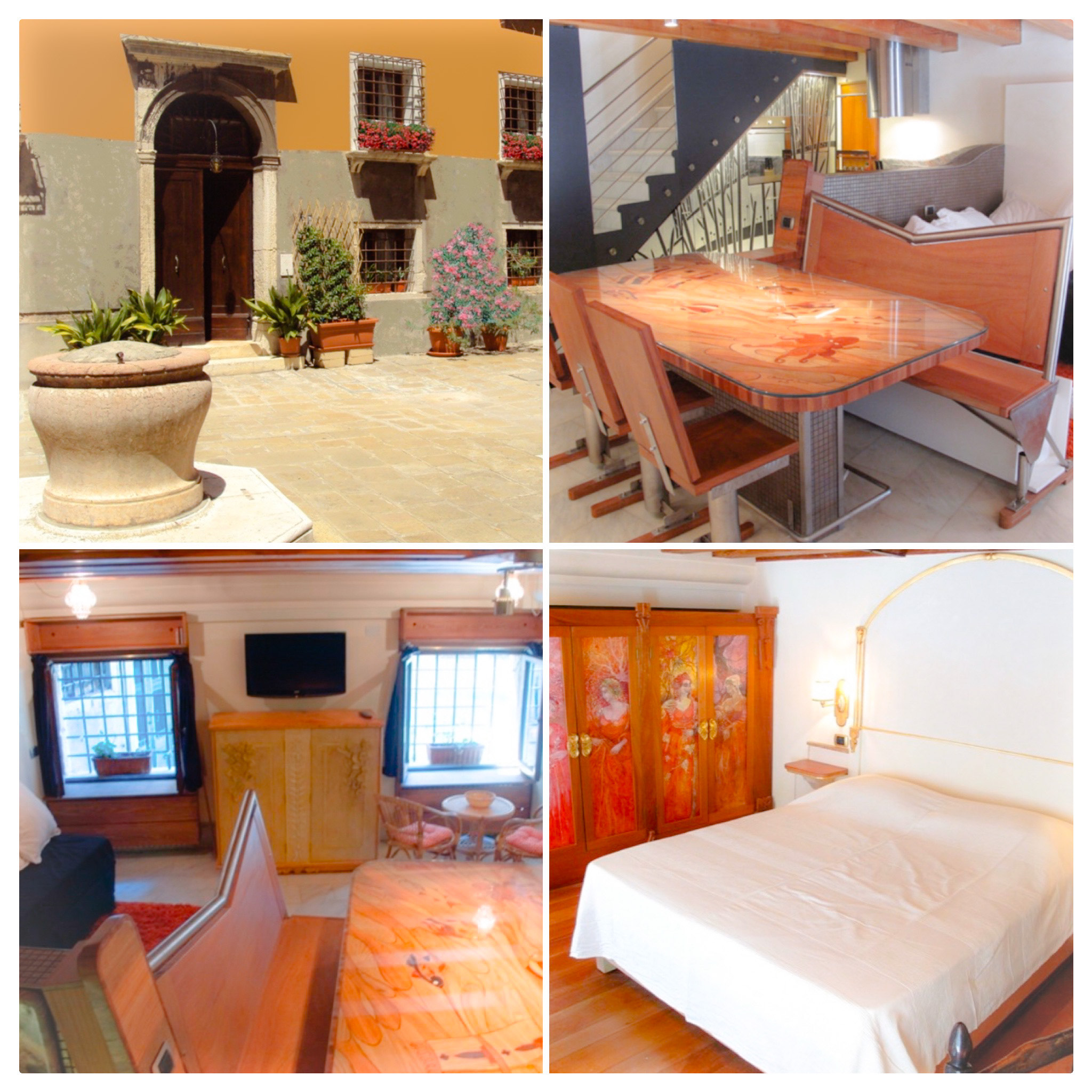A voyage into Carlo Goldoni's soul and theatre

Carlo Goldoni is certainly one of the most emblematic characters of 18th century Venice, who has linked his name to the history of Italian literature and beyond, in an indelible way.
Born in the Republic of Venice on February 25th 1707, he spent his life in the continuous search for a balance between the two natures that tormented his soul: the incessant need for peace and serenity against the constant thirst for knowledge that led him to travel often.
As a young boy he moved to Perugia first and then to Rimini, where his medical father began to study philosophy and law, obtaining a degree in law in 1731 at the University of Padua. But life and the profession of lawyer bored him terribly and Carlo's love for the theatre, which began at a very tender age, when he was only 8 years old and he became passionate about puppet theatre. He was constantly immersed himself in readings by theatre italians and foreigners autors, and gradually began to give life to his personal production, writing pieces, poems, dramas, but also librettos for operas in music. A production that became unstoppable and that undoubtedly marked the entire 18th century, making him one of the main founding fathers of modern comedy, the creator of what is known as the "theatre reform".
At the time of Goldoni the city of Venice was equipped with numerous theatrical facilities, many of which were private. And there were basically two ways of doing theater: there was the commedy of art, very popular because it was a popular type of entertainment for the lower classes of society; and then there was the aristocratic theater, which was staged in private living rooms, academies and courts, exclusively for the nobility.
You see how at the time, in the "democratic" Republic of one of the world's major powers, social differences were also reflected in the cultural, not only economic, gap: modes, languages, entertainment and pastimes were clearly discordant, widening the already excessively evident gap between social classes.
Beyond the social differences, the genre and the way of "making theatre", whether for the people or for the rich, was almost the same: it was a farcical genre, whose acting was entrusted almost exclusively to the actors' improvisation. There was no script written with parts and lines, but a plot that told the story, whose dialogue was improvised by the actors on stage. Moreover, the use of the mask was fundamental to represent an extremely characterized characters, in what we can define in all respects a play by subject.
Goldoni's reform was undoubtedly revolutionary. The playwright's play was not a simple farce in itself, but it put on stage psychologically characterized characters who, through cheerful and funny comedy, showed the thousand facets of the human soul, often fought by inner conflicts. He represented life and man, Carlo Goldoni, putting real characters on stage, inspired by his Venice, but which contained an extraordinary universality, arriving at a very modern realism. It's okay to laugh, it's good for the soul to have fun, but this became a pretext for inner psychological reflections: so Goldoni's theatre became a moral theatre with an important pedagogical role.
And for his reform the playwright imposed two fundamental innovations. The play was no longer a subject, completely eliminating improvisation and replacing the canvas with the script: the writing of the texts was for dialogues that the actors had to learn and follow. Even the language underwent a considerable change, no longer being sophisticated with brainwaves, but rapid and frank and above all dialectal: Carlo brought Venetian language back into the limelight, but with his genius he was able to avoid the caricatured aspect in which it could trivially expire.
The other great change was the abolition of the masks on stage: a "drop the mask" in favour of real and tangible human expressions, characters that had to do with reality and not with a certain fake fantasy.
In fact, it was Goldoni himself who recounted that his inspirations for theatrical writing came from reading two great books: the "book" of the world, from which he was able to draw situations and settings, characters and feelings to stage reality; and the "book" of theatre, fundamental for the knowledge of tricks and techniques, strategies to be followed by authors and actors, to be able to arouse wonder and laughter, to excite the spectator. The books to which Goldoni was inspired were not flipped through, but lived, and this sheds light on how important it is to study real life in order to then be able to afford to stage situations that must then offer real reflections, a moral, teachings. And this is why I find Carlo's way of working extremely astute and intelligent, consistent with his genius. An example not only for literature and theatre, but for life!
But what were the characters that Goldoni was telling? A central role in his comedies was given to the bourgeoisie, represented with positive, intelligent and enterprising characteristics, with good professional skills that allowed them to get rich, gradually replacing the traditional nobility. There were the servants, considered quite intelligent and cunning, to the point that they could criticise their bourgeois masters. Then there were the small people, such as fishermen, gondoliers and comrade gossips, whose lowest characteristics are represented, but also their best qualities as honesty and strong sense of family. And then there is the nobility, staged entirely without values, and the old aristocracy ridiculed for its arrogance. Let's see how Goldoni manages to represent the strident contrast between the different social classes in an always grotesque action with a sociological and moral implication.
Love is certainly an ever-present component of the playwright's stories, represented above all by young people who, however, must submit to social and family rules, but the happy ending is always assured.
The first opera that Goldoni wrote for the "new theatre" was La donna di garbo in 1743. In that period he worked at the San Samuele Theatre, belonging to the Grimani family. In 1747 he met the theatre impresario Gerolamo Medebach who took him to the San Angelo Theatre. But he changed again and in 1753 he passed to the Teatro San Luca, of the noble Vendramin family.
Ten years later Carlo left Venice and moved to Paris where he worked for the Theatre Italien: a period of great success, followed by an inexorable decline that led him to the black misery. After writing his Memoires, an autobiography between the serious and the facetious, he died in the French capital on February 6, 1793, leaving a great legacy to the world of literature: 5 tragedies, 16 tragicomedies, 137 comedies, 2 sacred actions, 20 interludes, 13 dramas, 49 playful dramas, 3 farces, 57 scenarios. An important heritage to protect and continue to live because it is always very modern.
Most of his masterpieces are set in Venice, such as The locandiera with the servant Mirandolina, and then I rusteghi, Il campiello, Le baruffe chiozzotte inspired by the events of Chioggia where he lived several years with his mother, and still Sior Todero Brontolon, La casa nova, Le donne curiose and many more.
Venice, on his part, responded by dedicating to the genius of Goldoni a Theatre in Calle del Teatro in the Sestiere di San Marco, a statue that stands proudly in Campo San Bartolomeo, at the foot of the Rialto Bridge, a Museum and an accommodation facility in what were his Venetian residences.
Carlo Goldoni's House: the Museum and Centre for Theatrical Studies

Though far from Venice, Charles never forgot his homeland and from melancholy Paris he wrote: "Je suis nè a Venise l'an 1707, dans une grande et belle maison, situeèe entre le Pont de Nomboli et celui de Donna Onsta, au coin de Rue de Centanni, sur le paroisse de S.. Thomas" (I was born in Venice in 1707, in a large and beautiful house situated between the Ponte dei Nomboli and Donna Onesta, on the corner of the Casa dei Centanni, in the Parish of San Tomà), recalling the palace where he had always lived. It was Cà Centanni, dating back to the 15th century. A typical palace with a classic Venetian layout, with an entrance on the calle and the long facade that rises from Rio de San Tomà, of which it perfectly follows its course bending gently into an large corner. In gothic style with a splendid internal courtyard with terracotta paving that goes as far as the porticoed entrance hall open onto the water door. A connotative element is undoubtedly the open staircase with sloping Gothic arches and a balustrade of Istrian stone columns. On the upper floors, the classic portego, which serves as the main axis, loses its function here due to the irregularity of the plan: it is reduced to a simple hall on which the various private rooms open, and marked on the outside by the splendid four-light window, with high columns and pointed arches, which stands out against the red brick of the façade, dominating it. The top floor, evidently lower, has a less scenic three-light window and simple openings that give a harmonious balance of full and empty spaces to the entire composition.
Charles stayed here until 1719. The building then belonged to Countess Ida Manassero Camozzo, and in modern times it was purchased by Aldo Ravà, an 18th century Venetian expert, together with Count Piero Foscari and Antonio Pellegrini: the three had the intention of creating a museum in homage to Goldoni and his work. The project, however, never saw the light of day because of the World War and in 1931 it was donated to the Municipality: and so in 1953 Carlo Goldoni's House, Goldoni's Museum and theatrical studies centre was inaugurated.
Today the Museum offers the opportunity to immerse oneself in the settings of Goldoni's works, an extraordinary journey through the Venice of the eighteenth century staged in his comedies, which is also a pretext to show customs and costumes, objects and furnishings of everyday life of the Serenissima.
The staircase of the courtyard in this itinerary becomes a separating element between an external and an internal, almost intimate itinerary. The ground floor, in fact, is presented with a large topographic map of Ughi of 1729 in which are indicated all the places dear to Goldoni, such as the houses where he lived, the theaters that saw him as the undisputed protagonist, the places frequented. Walking down the stairs to the upper rooms, the exterior becomes internal and you are completely catapulted into the eighteenth-century city and its dynamics,with the repetition of some scenes of his comedies. It's a bit like being on stage with the actors, with Carlo Goldoni directing the action.
And so in Room 1 we find these settings:
1. "The Conversation", Scene XIV, which features gambling: the scenic island includes the biribisso table, very fashionable at the time;
2. "The Venetian lawyer", Scene I: the scenic island is made with a typical furniture of a law firm of the time, extremely sophisticated;
3. "La donna di garbo", Scene VI: here the scenic island takes us to the house of a doctor, where there are the figures of Harlequin and Brighella;
4. "The obedient daughter", Scenes IV, V, VI: the scenic island is dominated by the presence of a small chiselled wooden table and a portrait of Goldoni himself on the wall;
5. "The Fake Sick", Scenes V, VI: the scenic island presents with a dormesuse as a party costume decorated with a macramé bib made of silver threads.
In Room 2:
1. "Chi la la fa l'aspetti", Scenes VII, VIII: here is represented a dining room where lunch has just taken place, rich in precious finely carved wooden furniture, and Longhi's paintings "La colazione in villa" and "I pasatempi in villa";
In Room 3:
1. "The Player", Scenes II, IV: gambling is still the protagonist here. The scenic island looks like a gambling place dominated by a table on which the player fell asleep after playing all night and winning several gold coins. On the wall there is still a painting by Longhi, "Il parlatoio", in which a child playing with puppets appears. And in the room there is, in fact, a puppet theatre of the period, which belonged to the Grimani family, a triumph of Venetian craftsmanship, not only for the clothes worn by the characters, but also for the ingenious mechanism that allowed to move the puppets. In the small theatre are represented the Scenes XIII and XIV of "Il servitore di due padroni", by Goldoni of course.
On the top floor there is the Library Centro Studi Teatrali, where more than 30,000 volumes and documents specialized in the theatrical and entertainment sector are kept: it is one of the most important centers specialized on the subject at international level.
Visiting Carlo Goldoni's House is not simply visiting a museum, but it is a journey into the wonderful theatricality of a timeless artist, who was able to tell us, perhaps better than others, the Venice of his time, giving us through his extraordinary characters a still extremely modern and contemporary teaching.
Have a good trip!
The House of Carlo Goldoni, Goldoni Museum and theatrical studies centre is in Rio Tera' dei Nomboli, 2794, San Polo 30125.
Discover Carlo Goldoni House

Between the end of 1748 and until the summer of 1761 Carlo lived with his beloved mother in an apartment just behind St. Mark's Square, in the elegant Corte di San Zorzi. It was in this simple residence that the playwright lived his most productive professional period, writing a large number of comedies for the Teatro San Luca, many of which were set in the Venetian calli.
The palace that housed the Goldoni family's residence is in Renaissance style and is not very sumptuous and has rather simple architectural lines: however, it was still a building a few steps from the heart of the city, that Piazza San Marco, the seat of political and religious power of the powerful Serenissima. Rather high by the standards of the time, it rises for 5 floors! The central portego highlights the main axis of the structure, and private rooms open onto it, as in a classic Venetian-style construction. This is underlined on the façade by the presence, on the noble floors, of splendid three-light windows with columns and round arches in Istrian stone, balanced by simple openings that give a pleasant balance to the composition. The entrance is entrusted to a classic style portal, with an arch and volute as the keystone, and a linear lintel that underlines the closure.
Today, that apartment houses an accommodation facility, a bed & breakfast, Carlo Goldoni House, that will give you the opportunity to stay within the walls that belonged to the master of the theater of the eighteenth century.
The Casa Carlo Goldoni is on two floors, a terraneum where you can find the large living area with a brick kitchen and the relax area with sofa and TV; and the first floor where there is the sleeping area with the large bedroom and the bathroom with Jacuzzi to relax after a busy day around the city.
The apartment is equipped with all the comforts to make your visit as pleasant as possible, such as heating, air conditioning, a safe and wi-fi service. The furniture is tasteful and also very modern, while the ceilings have wooden beams, typical of Venetian houses. The large windows on both floors allow natural light to enter for most of the day, to better envelop you in the warm Venetian atmosphere. The location inside a courtyard reserved and almost hidden from the flow of tourists will make your stay quiet, outside the hustle and bustle of the most central areas.
The centrality of the structure makes every area of the city accessible, especially the vaporetto stops for any movement, but also the most elegant streets such as Mercerie, Calle Larga XXII Marzo and Riva degli Schiavoni. A few steps between the calli and you reach the Rialto area, for the youngest nightlife in Venice. The proximity, instead, to the Orseolo Basin will allow you to make a romantic gondola tour, if you want.
Casa Carlo Goldoni, to experience Venice as a true Venetian, like Carlo Goldoni!
Carlo Goldoni House is in Corte Zorzi, San Marco 1080, 30124.










Lascia un commento